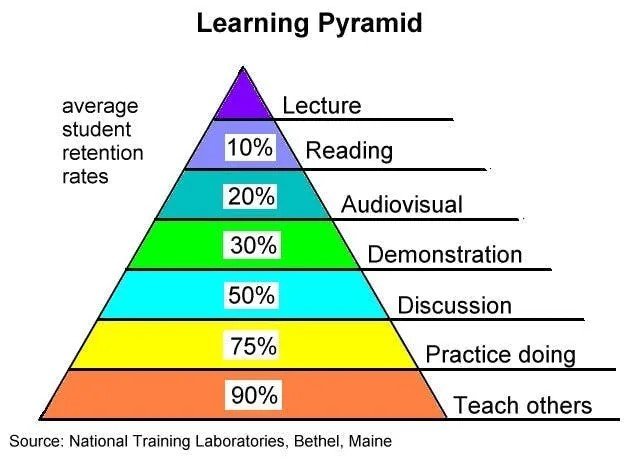Feynman Technique: The Art Of Learning
The lamentations about the educational system's inadequacies are as old as the system itself. Rote memorization often leads to fleeting knowledge, a superficial grasp overshadowing deeper understanding. Reflecting on my school days, I frequently found that the knowledge I gained, acquired through endless lectures and textbook readings, faded shortly after the course ended. This experience, I believe, is not unique to me.
Traditional learning methods have been proven ineffective, as evidenced by the Learning Pyramid developed by the National Training Laboratories Institute.
While the exact percentages in the Learning Pyramid might be a topic of debate, the essence of its message is clear and widely accepted. It brings us to two pivotal principles that form the bedrock of effective learning.
Fundamental Principles for Effective Learning
Before diving into the transformative learning approach called the Feynman Technique, let's acknowledge the two pivotal principles that the Learning Pyramid reveals:
Traditional learning methods are often ineffective for lasting retention.
Teaching is the most effective form of learning.
Armed with these insights, we can better appreciate the merits of the Feynman Technique.
Historical Context
Richard Feynman, from whom this technique gets its name, was more than just a physicist — he was a master communicator. Born in 1918, Feynman made significant contributions to the field of quantum mechanics, for which he was awarded the Nobel Prize in Physics in 1965.
But beyond his academic achievements, Feynman was renowned for his exceptional ability to explain intricate scientific concepts in plain, accessible language. His popular lecture series, “The Feynman Lectures on Physics,” is a testament to his teaching prowess.
Feynman believed in understanding over memorization, and often remarked that if he couldn't explain a topic in simple terms, it meant he didn't truly understand it. This philosophy laid the groundwork for the Feynman Technique.
By encouraging learners to break down complex ideas and teach them, Feynman's approach transcends traditional rote learning, offering a method that promises genuine comprehension.
The Four Pillars of the Feynman Technique
Given Feynman’s beliefs and principles, it's no wonder his technique strongly focuses on true comprehension. Let's delve into the specifics of this method.
The Feynman technique can be distilled into four integral steps:
Set the Stage:
Goal: Establish a foundational understanding.
Action: Begin with selecting your desired topic. Create a document or grab a piece of paper and note down all your current knowledge about the subject. This is your starting point. From here, proactively engage with various resources. Listen to lectures, delve into books, watch related documentaries, and even engage in discussions with experts or enthusiasts. The idea is to saturate yourself with information, starting with a broad overview and gradually diving into the intricate details. As you encounter new insights or deeper understandings, keep adding them to your initial notes.
Teach it to a Child:
Goal: Simplify to amplify.
Action: Once you feel you've absorbed significant information, it's time to test your understanding. Imagine trying to explain the topic to a 12-year-old child. This age is selected intentionally, as it represents a stage where complex ideas must be broken down into their simplest forms. If you find yourself resorting to technical terms or jargon, it's an indication that your understanding might still be surface-level. Strive for clarity and simplicity. If a concept can't be made simple, it's often not understood well enough.
Identify Gaps:
Goal: Pursue holistic understanding.
Action: After your teaching attempt, it's reflection time. Ask yourself: Were there points I stumbled over? Were there concepts that I couldn't translate into simple terms? Did I skip over certain areas because I wasn't confident in them? Take note of these areas. They represent the gaps in your knowledge and understanding. Identifying these gaps is crucial because it gives direction to your subsequent learning. It pinpoints exactly where you need to revisit and what you need to relearn or understand better.
Organize and Simplify:
Goal: Create a coherent narrative.
Action: After filling in the gaps, you should have a comprehensive set of notes that cover the topic in detail. But a jumble of notes isn't the most effective learning tool. Organize your findings into a clear, logical narrative. It should flow like a story, with a beginning, middle, and end. This structured approach not only makes the information more digestible but also embeds it more deeply in your memory. As a final step, read your narrative aloud. If at any point it feels convoluted or unclear, loop back to the 'Teach it to a Child' step. The objective is to refine your narrative until it's a clear, concise, and coherent explanation that you'd feel confident sharing with anyone.
By embracing and repeatedly practicing these four pillars of the Feynman Technique, you equip yourself with a powerful tool for lifelong learning and mastery over any subject.
Conclusion
Not merely a technique—the Feynman approach is a philosophy to develop a deep mastery over any concept. It addresses the shortcomings of traditional educational paradigms and offers a robust, practical alternative.
As E.F. Schumacher once eloquently stated, 'Any intelligent fool can make things bigger, more complex, and more violent. It takes a touch of genius—and a lot of courage—to move in the opposite direction.'
In a world where complexity is often mistaken for sophistication, the Feynman Technique reminds us of the true power of simplicity.
Thanks for reading Wisdom & Prosperity!



